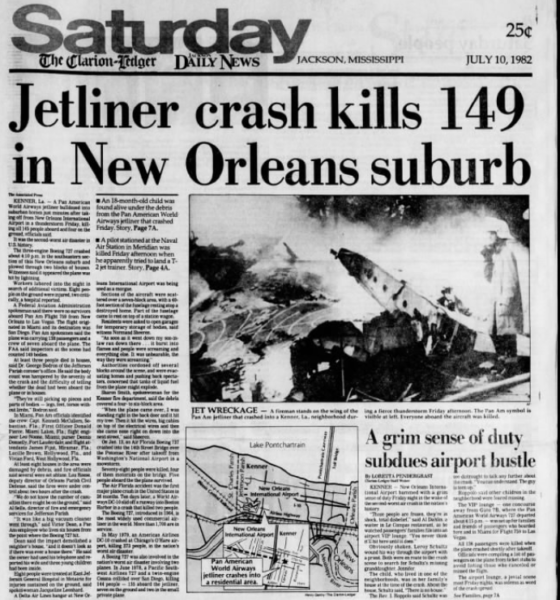Eliminating an Aviation Killer

On the afternoon of July 9, 1982, I was in Mobile visiting the public library and my friend Keith Blackwell. Storms formed along the seabreeze front. The storms were impressive in Mobile, but as I headed back to the hotel and got ready for dinner, the lead story on the evening news was shocking.
A Pan Am Boeing 727 had crashed in the New Orleans suburb of Kenner at 4:11 p.m. Flight 759 had originated in Miami bound for Las Vegas with a scheduled stop in New Orleans. The plane, with 7 crewmembers, 1 non-revenue passenger in the cockpit jumpseat and 137 passengers on board, taxied to take off just before 4 p.m. even as a thunderstorm was building in the area.
Wind shear had been downing planes for decades. But the crash of Eastern Airline 66 at JFK on June 24, 1975 led famed researcher Theodore Fujita to study the cause of the crash. In 1977, Dr. Fujita published a paper describing a form of wind shear they named a downburst.
Amazingly, many meteorologists and aviation experts didn’t accept the findings. And wind shear continued to claim commercial aircraft with tragic results.
But after the Eastern crash, the FAA did respond by installing the Low Level Windshear Alert System I at 110 airports over the next 11 years.
That system was in place at the New Orleans International Airport on July 9, 1982. As the Pan Am flight (Clipper 759 in air traffic jargon) taxied into position, air traffic controllers were warning another plane of wind shear in the northeast quadrant of the airport. The first officer on Clipper 759 asked for a wind check at 4:03 p.m. The controller responded: “Wind now zero seven zero degrees at one seven…peak gusts two three, and we have low level wind shear alerts all quadrants, appears to be a frontal (sic) passing overhead right now, we’re right in the middle of everything.”
The captain advised the first officer to let airspeed build up on takeoff and they should down the air conditioning to increase the thrust on engines one and three. At 4:06 p.m., Clipper 759 notified the tower it was ready for takeoff and was cleared. The controller who delivered that clearance would say that it haunted his every decision over the remainder of his career.
The plane began its roll and used 7,000 feet of runway to lift off. It attained an altitude of 150 feet or so before it began to descend. It was encountering the downburst, a dangerous rush of rushing out of the storm near the end of the runway. The doomed plane struck a plane at about 50 feet near Williams Blvd.
The plane veered to the left slightly and rolled onto its left side, cutting a furrow in the ground. It would crash into a neighborhood just south of West Metairie Avenue, destroying or severely damaging 15 homes and killing 8 people on the ground.
The National Transportation Safety Board would say that the pilots made a sound reasonable decision based on the information that they had. Some disagreed with that assessment.
But planes would continue to fall from the sky during thunderstorms. The crash of Delta 191, an L-1011, at Dallas-Fort Worth International Airport on August 2, 1985 would be the game changer. Dr. Fujita would use the data from the black box on the plan plus the instrumentation at the airport to prove that it had been a downburst that had crashed the plane. A total of 137 people died and 28 were injured.
The FAA would put a new wind shear avoidance and response course into production. A new LLWAS was installed at airports. Terminal Doppler Weather Radars would be installed at 44 airports across the country starting 1994.
One last major wind shear related crash would occur. On July 2, 1994, USAir flight 1016 tried to land in a strong thunderstorm at Charlotte-Douglas International Airport. As the crew flew the final approach, they encountered intense wind shear in an area of heavy rain and their evasion efforts were too little, too late.
The threat is not gone, but science has effectively eliminated wind shear as a major contributor to airline crashes.
Category: ALL POSTS, Met 101/Weather History


















